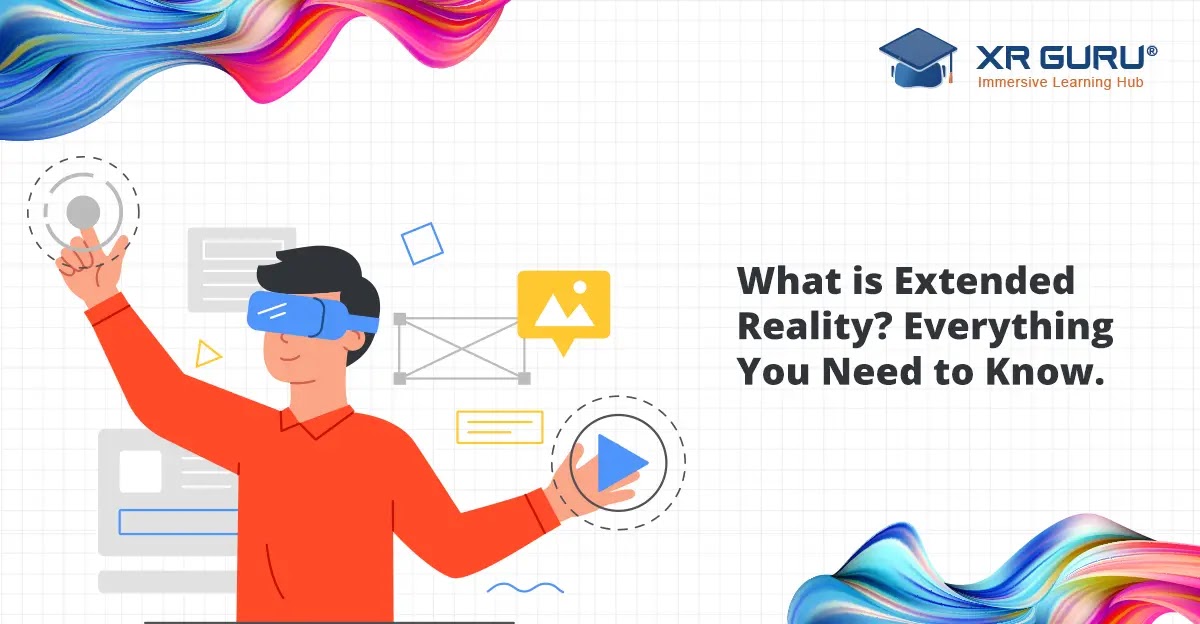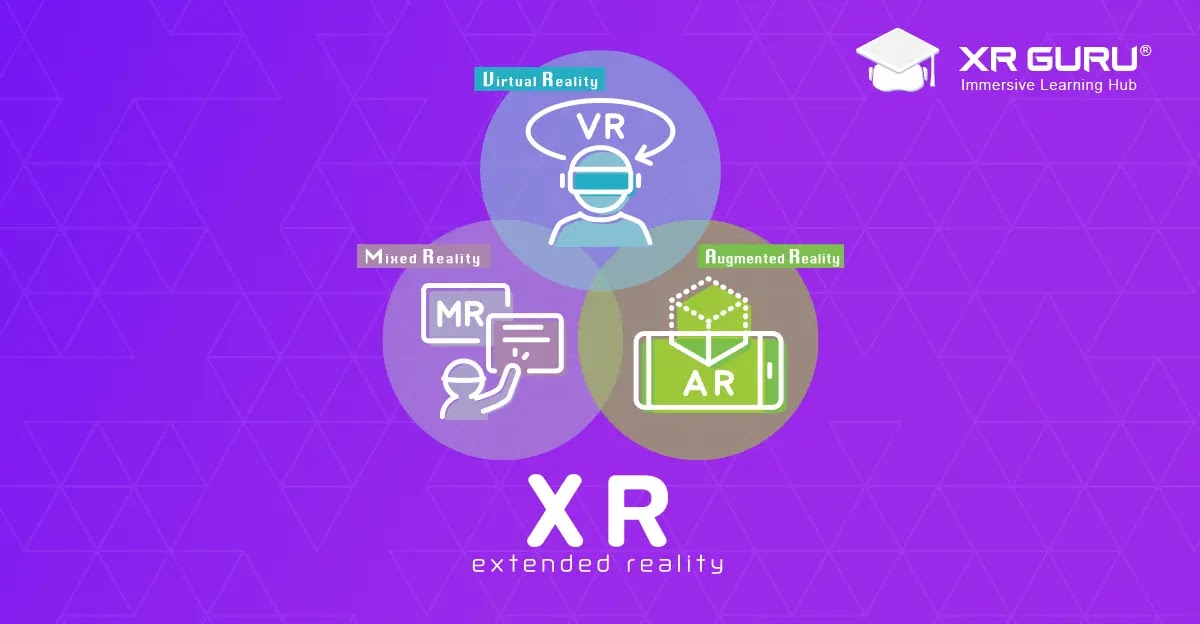Introduction
Extended reality is drastically changing on a virtual level, and constantly increasing our understanding of the physical world. This technology is by no means new, but after gaining more mainstream recognition around 2010, the real world saw the benefits of XR technology in gaming and entertainment. Not many people really knew what it was or what it was called. Simply that VR was a thing. With the start of the pandemic in 2020 and social distancing, understanding of the industry and the benefits it could provide the world at large have grown and will continue to grow well into the future. Even still, the distinctions between each facet of the technology are often overlooked. So, here's everything you need to know about XR technology.

The blog covers:
-
1. What is Extended Reality?
-
2. Three Types of XR Technology
-
3. Current Applications
-
4. Negative Impacts of Extended Reality
-
5. Current Projects
-
6. Future Possibilities
1. What is Extended Reality?
Extended reality (XR) refers to any digital environment in combination with the physical world, where the user can interact with the environment using handheld and wearable technology. Through extended reality, the user can have a unique range of experiences they wouldn't typically be capable of in real life. This could include anything from visiting the Louvre to overlooking a game city as if they actually ran along the rooftops, to something as simple as holding a 3D image of a heart in their hand.
2. Three Types of XR Technology
There are several different types of XR technology to be noted. They are often conflated because each of them interacts with the virtual world in one way or another. But there are some very important distinctions and understanding each area will help understand XR as a whole.
- Augmented reality (AR) refers to the overlaying of graphic images using a handheld device, such as a smartphone or tablet, in order to interact with the digital world. This is the most basic and accessible form of XR, given that no extra expense must be spared for gear. An app and a smartphone or tablet are all that's needed.
- Virtual reality (VR) is more costly because the user must first have a VR headset in order to interact with the virtual world. It takes the user visually away from the physical space they're in and puts them entirely into a digital world. Using sensory technology, the user is also able to physically interact with the environment.
- Mixed reality (MR) is a combination of both and is a little bit harder to understand. It's a hybrid that involves physical interaction with digital objects in a physical environment in real time. It's closer to AR in that it involves digital objects overlayed onto a physical field. It's connection to VR is that it allows the user to actually move these objects to a specified space in the physical world, thereby giving the tech a more balanced interaction. Think of it as a physical version of the Ikea app that allows the user to see the spatial placement of a couch, but instead of just using it on a phone (strictly AR), the user can digitally place the couch in the room in a physical capacity to see how and where it would fit best.
The diagram below shows the relationship between these three subsets and how they all meet together to create what is known as extended reality.

3. Current Applications
Since extended reality gained traction in mainstream spaces, more industries are recognizing the potential for using XR technology for their needs. For instance, VR has proved especially useful for gamers and entertainers alike and allows for more interactive and immersive play. Schools are using VR and AR to give students another way to expand on the things they're already learning. From something so major as that to that little yellow line that sports commentators have used for decades to dissect plays- yeah, that's extended reality too.
As technology has grown, so have its uses. The healthcare industry has been able to use extended reality to help with patient care and environmental safety practices. Worker training time has drastically reduced in various fields by offering training via virtual and augmented reality. Educational sectors have found that by using similar practices, teachers are able to offer a more complete educational experience.
4. Negative Impacts of Extended Reality
With anything, there are positive benefits and negative impacts of extended reality. While XR is still relatively new and ever evolving, it's important to recognize the very real harmful aspects of it. Along with cyber security issues that are already a major problem with any sort of technology, there are other societal impacts that could currently be detrimental to society as a whole. For instance, addiction to technology is rapidly increasing due to the nature of technological advancement. It's already an issue with video games, television, and smart devices where people are engaging more with technology than with the world around them.
Stemming from this, social interaction may take a major hit with the amount of time spent on XR devices. Lack of social interaction leads to a lack in the capability to interact with others and removes empathy and understanding. With the wider acceptance of virtual reality and applications like it and its use in mainstream society, it may become more socially acceptable to have young children using it for an extended period without parental guidance, a problem that has already been noted with tablets, phones, and television. One study led by psychologist Sheri Madigan, PhD, found that in ages 24 months to 36 months, increased screen time led to poor performance for behavioral, cognitive, and social development on screening tests. (Source)
While there are drawbacks, the positive benefits for those who widely use extended reality technology far outweigh the negative.
- The learning curve for various industries is drastically reduced.
- Informational retention rates are raised exponentially.
- Immersive environments allow for more focused learning.
- Training in a safe environment is more widely accessible.
- There are reduced training and liability cost.
The important thing to note about the negative aspects is that, while XR technology has been around for a while, it is still relatively new. The negative impacts can be reduced by being proactively educated about them.
5. Current Projects
As of right now, there are already many ways to use XR technology. It all depends on your needs and what you hope to gain from using the tech. AR, being the most accessible, has a wide range of apps that can be downloaded onto a phone or tablet. Just for the year 2022, the new Oculus Quest 2 headsets have been released, with devices being used in workplaces, schools, and homes. Facebook announced their own work with the metaverse, as well as RayBan-style smart glasses.
6. Future Possibilities
Necessity breeds innovation. As Mr. Bigweld says in Robots, "See a need, fill a need," and that's exactly what's happening with extended reality. XR Technology is transforming the landscape of what is conceivably termed "reality." With the pandemic in 2020 and the need to stay at home came the desire for more immersive experiences. This led to a rapid expansion of what could be possible with XR tech. It went from a rather novel concept with more entertainment focus, to an integral part of society. With virtual field trips, business meetings, and shopping trips, the necessity to socially distance became less daunting.
Conclusion
Extended reality is gaining recognition in many areas of business, entertainment, training, education, and healthcare. With its immersive nature and multiple modes of use, it's the perfect way to offer users a selective experience. Even with its drawbacks, the benefits have been proven highly effective in teaching, training, and informational retention. Whether your needs are specifically AR, VR, or MR, extended reality technology offers engaging experiences for the avid gamer and businessperson alike. As of today, the future of XR technology is bright.
Anna Taylor is a freelance writer and avid researcher- a jack of all trades, but a master of none. She graduated from the University of Hawai'i with an Associates Degree in Liberal Arts because she had no idea what she wanted to be when she grew up. She has since found her love of Extended Reality and the possibilities it brings to the world, as well as gardening, cooking, and writing. Anna lives in Interior Alaska with her family.